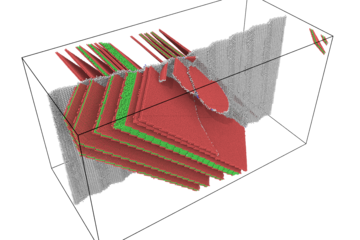All genres
41.
Talk
Crystal plasticity of titanium quantified through orientation informed nanoindentation and crystal plasticity finite element simulation. Euromat 2011, Montpellier, France (2011)
42.
Talk
Computational Crystal Plasticity. Korea Institute of Science and Technology (KIST), Seoul, South Korea (2011)
43.
Talk
Surface Topographies after Nanoindentation and their Utilization to Quantify the Plastic Anisotropy of Gamma-TiAl on the Single Crystal Length Scale. MMM 2010, Freiburg, Germany (2010)
44.
Talk
Crystal plasticity modeling and experiments to improve the micromechanical understanding of single crystal gamma-TiAl and gamma-TiAl based microstructures. MMM 2010 Fifth International Conference Multiscale Materials Modeling, Freiburg, Germany (2010)
45.
Talk
Computational Crystal Plasticity. Invited keynote lecture, Conference on Optimising Performance Through Integrated Modelling of Microstructure (OPTIMoM), Cambridge, UK (2010)
46.
Talk
Mechanical size effect analysis in metals and biological materials. Invited keynote lecture, Micromechanics Conference II, Oxford, UK (2010)
47.
Talk
Surface Topographies after Nanoindentation and their Utilization to Quantify the Plastic Anisotropy of Gamma-TiAl on the Single Crystal Length Scale. Materials Science and Engineering MSE 2010, Darmstadt, Germany (2010)
48.
Talk
How nanoindentation experiments and continuum crystal plasticity simulation can efficiently complement TEM dislocation analysis. 2nd Newcastle Nanoindentation Conference, Newcastle upon Tyne, UK (2010)
49.
Talk
Quantifying the plastic anisotropy of gamma-TiAl by axisymmetric indentation. International TiAl Workshop, Birmingham, UK (2010)
50.
Talk
Crystal plasticity analysis of nanoindentation in intermetallic gamma-TiAl. Nanomechanical Testing in Materials Research and Development, Barga, Italy (2009)
51.
Talk
Crystal plasticity modeling for property extraction and the microstructure properties relation of intermetallic -TiAl nased alloys. 1st International Conference on Material Modelling (ICMM 1), Dortmund, Germany (2009)
52.
Talk
Crystal plasticity modeling and experiments for the microstructureproperties relationship in gamma TiAl based alloys. 15th International Conference on the Strength of Materials (ICSMA-15), Dresden, Germany (2009)
53.
Talk
Ductility of Gamma-TiAl-Based Microstructures in the Light of Deformation Mode Interaction-Crystal Plasticity Modeling and Micro-Mechanical Experiments. MRS Fall Conference 2008, Boston, MA, USA (2008)
54.
Talk
Determination of Texture and Microstructure of Ordering Domains in gamma-TiAl. 15th International Conference on the Texture of Materials (ICOTOM 15), Pittsburgh, PA, USA (2008)
55.
Talk
Micro-mechanical implications of TiAl order domains. The annual plenary meeting of the EU sixth framework programme IMPRESS integrated project, Camogli, Italy (2008)
56.
Talk
Order domains in intermetallic TiAl - EBSD characterization and crystal plasticity modeling. GLADD meeting, University of Gent, Gent, Belgium (2008)
57.
Talk
Crystal plasticity of TiAl microstructures. Maruyama Laboratory, Tohoku University, Sendai, Japan (2007)
58.
Talk
Primary Recrystallization of a Single-Crystal Nickel-Base Superalloy — Simulations and Experimental Results. High Temperature Alloys Workshop and Summer School, Bad Berneck (2006)
59.
Talk
Spherical indentation modeling for the investigation of primary recrystallization in a single-crystal nickel-base superalloy. Plasticity, Halifax, Canada (2006)
60.
Talk
3D EBSD characterization and crystal plasticity FE simulation of the texture and microstructure below a nanoindent in Cu. Plasticity Conference 2006, Halifax, Canada (2006)











